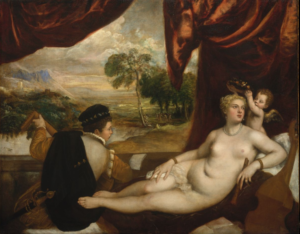
The painting that captured my attention at first sight was the canvas painting of Venus and the Lute player. Tiziano Vecellio, better known as, Titian created this painting during 1560. The setting of Titian’s painting focuses on three figures, the Greek goddess Venus, her love child Cupid, and a Lute player, in a setting showing a room that has lavish curtains and overlooks a landscape. I was attracted to Titian’s Venus because of my admiration of the Goddess Venus in my previous studies of Greek mythology. Venus also known as Aphrodite was the goddess of love, beauty and sex. In this painting, Titian portrayed Venus as a sensual and angelic woman, who has the ability to capture the viewers’ attention with her intense expressions. The painting depicts a nude Venus seated on a coach in a sensual position. She is wearing a white pearl necklace and expensive earrings. In the painting one can only see the profile of her face, which has an intense and subdued expression. Behind Venus is her son Cupid, who has a smaller figure and is holding a crown made of flowers over Venus’ head. The lute player is an important figure in this portrait because he is seen looking at Venus and it appears that he is playing music with his instrument. Behind the figures there is a window that overlooks a landscape, which consists of green trees, grass, and mountains. According to the gallery label, the painting has been thought to “address the Neo-Platonic debate of seeing versus hearing as the primary means for perceiving beauty.” My interpretation of the general theme or purpose of this canvas painting is its portrayal of the love for beauty and music. I hindered upon this theme based on the idea that artists from this time period idealized the female body as that of beauty. According to the Metropolitan Museum, the figures of a nude Venus “highlight the seductive warmth of the female body rather than its ideal geometry.” Like many artists from the Italian Renaissance, Titian represented Venus nude in order to symbolize the female body, thereby, representing beauty. On the other hand, the lute player is an abstract figure that is assumed to signify the love or admiration of music.


